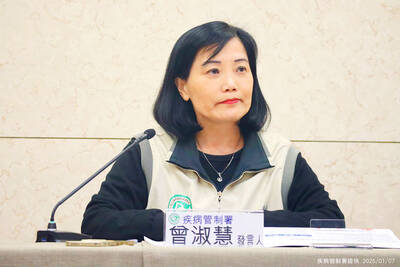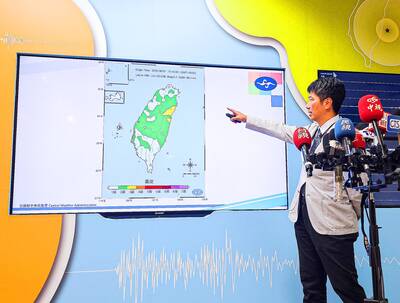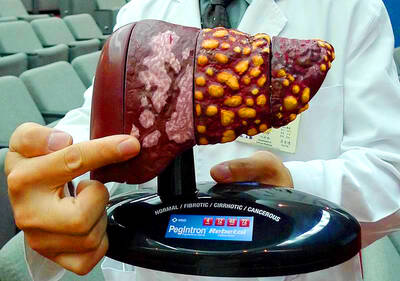A clinical trial developed by a Taiwanese research team has offered a glimmer of hope for patients of neuroblastoma, a malignant cancer that appears in early childhood, a press statement released by the Academia Sinica said.
The research team at the research institute has proven that a combination of anti-cancer monoclonal antibodies (mAbs) with cytokines (natural hormones that help the immune system) is an effective anti-cancer therapy.
The new immunotherapy treatment pioneered by the research team, headed by Alice Yu (陳鈴津), deputy director of Academia Sinica’s Genomics Research Center, is the first study that confirms that immunotherapy is effective in improving cure rates for this childhood cancer, the statement said.
Yu, a pediatrician, has been working on the therapy for more than 20 years. She completed the Phase I and Phase II trials of this antibody at the University of California in San Diego.
The latest Phase III trial was sponsored by the US-based Children’s Oncology Group (COG), a cancer research organization, and the National Cancer Institute of the National Institutes of Health in the US. The latest results included children with neuroblastoma from many parts of the world.
Neuroblastoma is a malignant cancer occurring in early childhood in which the cancer cells arise from the nerve cells in the neck, chest or abdomen.
It is the most common cancer diagnosed in the first year of life and is responsible for 15 percent of cancer-related deaths in children.
The Phase III study showed that children with high risk neuroblastoma who received the new antibody-based immunotherapy (chimeric anti-GD2 antibody ch14.18) have a 20 percent better chance of living free of cancer, a significantly improved cure rate.
So far, Yu said, all US Federal Drug Administration (FDA) approved therapeutic anti-cancer mAbs or vaccines are directed against protein or glycoprotein antigens.
“The Phase III clinical trial is the first mAb targeting a glycolipid that has been shown to be effective,” Yu said.
More importantly, she added, this is the first study that proves that immunotherapy is effective in improving cure rates for this childhood cancer and her team is now focusing on making sure immunotherapy can be available to all children with this disease and on improving results.
COG Chairman Gregory Reaman stated in a press release that the clinical benefit of this approach against the notoriously stubborn child cancer is extraordinary and that the COG is anxious to continue its investigation to better define the toxicities and confirm its satisfactory risk-benefit ratio.
“We are hopeful that that this further study will result in commercialization and FDA approval and licensing of this experimental immunotherapeutic agent so that it can be made readily available as standard therapy to all children with this dreaded disease,” Reaman said in the statement.
Conventional treatment for the disease includes surgery, intensive chemotherapy with stem cell rescue (in which patients’ stem cells removed before treatment are returned after chemotherapy to repopulate the blood and immune system) and radiation therapy.
Despite these aggressive measures, only 30 percent of patients survive.
The immunotherapy evaluated in this study targets a specific glycolipid (sugar and fat) molecule on neuroblastoma cells called GD2 — which inhibits the immune system from attacking cancer cells — with an antibody called ch14.18.
This antibody binds to GD2 and provokes an attack by different types of immune cells against the cancer.
In her study, Yu and her colleagues compared the two-year event-free survival rate (the ratio of patients who were still alive and did not experience a recurrence) of 113 neuroblastoma patients who received the standard treatment (retinoic acid) plus the newly developed immunotherapy with 113 similar patients who only received the standard treatment.
The event-free survival rate for the immunotherapy group was 66 percent, compared to 46 percent for the standard treatment group. The most common side effects in the immunotherapy group were pain, vascular leak syndrome and allergic reactions.
As the study is the first effective immunotherapy reported for the disease and the first improvement on neuroblastoma cure rates of the last 10 years, it has drawn worldwide attention and was reported in USA Today and by US television network CBS.
It is estimated that it will take at least another two years to get FDA approval for the therapy.

The Taipei Summer Festival is to begin tomorrow at Dadaocheng Wharf (大稻埕), featuring four themed firework shows and five live music performances throughout the month, the Taipei Department of Information and Tourism said today. The festival in the city’s Datong District (大同) is to run until Aug. 30, holding firework displays on Wednesdays and the final Saturday of the event. The first show is scheduled for tomorrow, followed by Aug. 13, 20 and 30. To celebrate the 30th anniversary of Disney Pixar's movie Toy Story, the festival has partnered with Walt Disney Co (Taiwan) to host a special themed area on

BE CAREFUL: The virus rarely causes severe illness or death, but newborns, older people and those with medical conditions are at risk of more severe illness As more than 7,000 cases of chikungunya fever have been reported in China’s Guangdong Province this year, including 2,892 new cases last week, the Centers for Disease Control (CDC) yesterday said it is monitoring the situation and considering raising the travel notice level, which might be announced today. The CDC issued a level 1 travel notice, or “watch,” for Guangdong Province on July 22, citing an outbreak in Foshan, a manufacturing hub in the south of the province, that was reported early last month. Between July 27 and Saturday, the province reported 2,892 new cases of chikungunya, reaching a total of 7,716

Aftershocks from a magnitude 6.2 earthquake that struck off Yilan County at 3:45pm yesterday could reach a magnitude of 5 to 5.5, the Central Weather Administration (CWA) said. Seismological Center technical officer Chiu Chun-ta (邱俊達) told a news conference that the epicenter of the temblor was more than 100km from Taiwan. Although predicted to measure between magnitude 5 and 5.5, the aftershocks would reach an intensity of 1 on Taiwan’s 7-tier scale, which gauges the actual effect of an earthquake, he said. The earthquake lasted longer in Taipei because the city is in a basin, he said. The quake’s epicenter was about 128.9km east-southeast

STAY VIGILANT: People should reduce the risk of chronic liver inflammation by avoiding excessive alcohol consumption, smoking and eating pickled foods, the physician said A doctor last week urged people to look for five key warning signs of acute liver failure after popular producer-turned-entertainer Shen Yu-lin (沈玉琳) was reportedly admitted to an intensive care unit for fulminant hepatitis. Fulminant hepatitis is the rapid and massive death of liver cells, impairing the organ’s detoxification, metabolic, protein synthesis and bile production functions, which if left untreated has a mortality rate as high as 80 percent, according to the Web site of Advancing Clinical Treatment of Liver Disease, an international organization focused on liver disease prevention and treatment. People with hepatitis B or C are at higher risk of